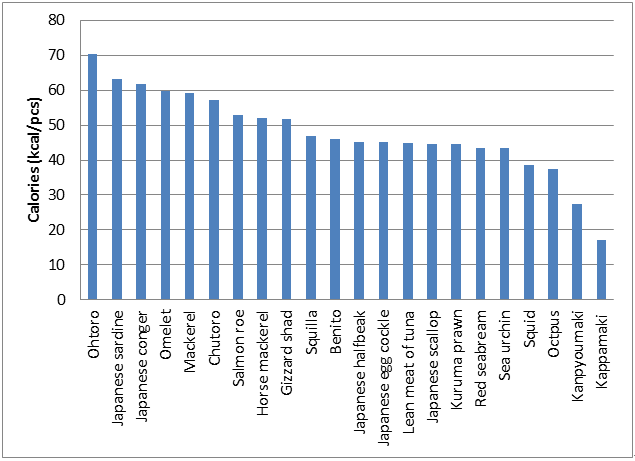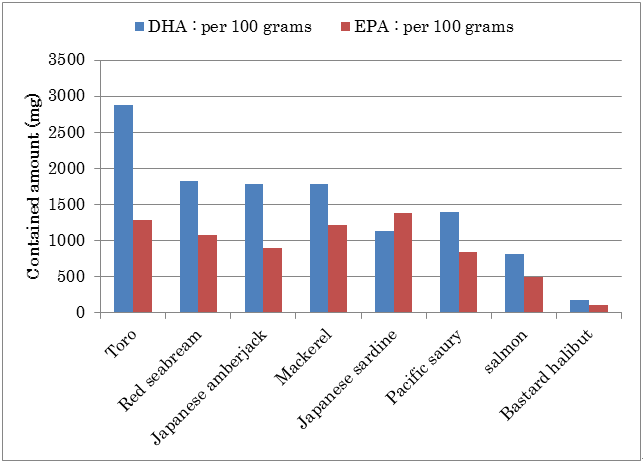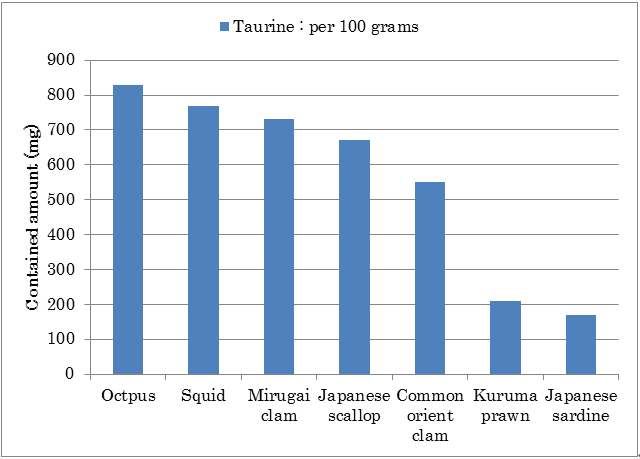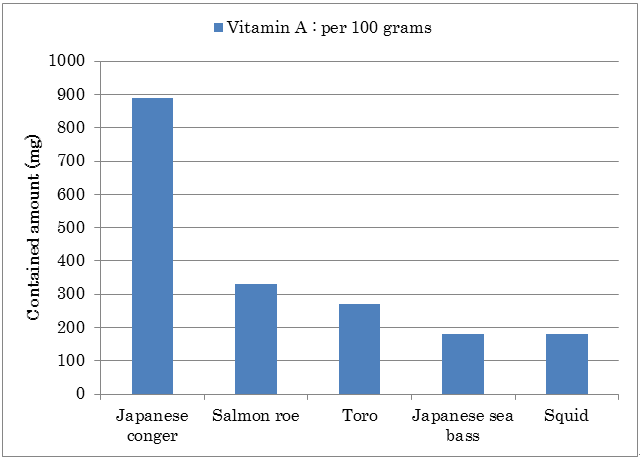The seafood used in creating sushi is a very nutritious product. There has been particular research into the health benefits of Docosahexaenoic acid (DHA) and Eicosapentaenoic acid (EPA), which are present in the fat of fish. The vinegar used is also good for your health. It lowers blood pressure and helps relieve fatigue. And depending on the size of the sushi, a meal is only about 450 to 600 calories if you eat 10 pieces. It is a much healthier option when you compare it with the 600 calories in a 200g sirloin steak.
Let’s take a closer look at the nutrients found in sushi and how you benefit from them.

The calorie data is based on one standard piece of sushi (20 g vinegar rice contains approximately 30.5 calories).
It prevents lifestyle-related diseases such as cerebral infarction, myocardial infarction and diabetes.
The essential fatty acid DHA is found in all fish and shellfish and has the effect of keeping the brain active and preventing aging. Very Fatty tuna contains a lot of calories, but it also has the most DHA of any sushi.

EPA, another essential fatty acid, may lower cholesterol in the blood and reduce the neutral fat, helping with circulation. This is found in large quantities in silver-skinned fish, gizzard shad, horse mackerel, mackerel and sardines.
Effects of taurine
Taurine is an amino acid, and a component that is present in almost all tissues of the body, but it is found particularly in crustaceans such as shellfish, shrimp and octopus. It has the effect of stabilizing blood pressure, preventing high blood pressure and arteriosclerosis, and lowering cholesterol levels in the blood. It also improves liver function, and recovery from fatigue.
Learn more about NORI (DRIED LAVER SEAWEED)

It improves eye function and prevents aging.
Vitamin A is abundant in sushi such as eel and sea urchin. It is said to improve eye function, preventing eye fatigue and stopping deteriorating vision. It may also improve the skin and mucous membranes, having an anti-aging effect.

Cancer prevention
Some people say, to help prevent cancer, it is important to consume adequate amounts of vitamins A, C, E and dietary fiber. Vitamin A acts to suppress the growth of cancer. Vitamin C acts to suppress the production of carcinogenic substances. Vitamin E has the function of preventing the senescence of somatic cells. It is thought that dietary fiber has the effect of cleaning the intestines and preventing colon cancer.
As an example, salmon roe and sea urchin are rich in vitamin A, but at the same time, they also contain a lot of vitamin E useful for preventing aging. The green tea consumed when eating sushi contains Vitamin C, and the dried gourd (kanpyo) at the end of the course contains plenty of dietary fiber.
Maintains physical health
Vitamins B1, B2 and aid in maintaining the health of the skin and mucous membranes. You’ll find a lot of these vitamins in salmon roe or yellowtail. Increasing potassium intake, which is abundant in Spanish mackerel and sea bream, has recently been linked to reduced blood pressure, prevention of stroke, and increased bone density. And shellfish contain high amounts of iron, required for making red blood cells.
Effects of vinegar
In clinical studies, vinegar has been shown to have countering effects for metabolic syndrome* factors such as reducing visceral fat, reducing blood pressure, and controlling elevated blood sugar levels. The bacteriocidal effects help to balance the intestinal environment, preventing constipation.
*Metabolic syndrome: This refers to visceral fat accumulation accompanied by at least two of either high blood sugar, increased blood pressure, and/or excess body fat.
Calorie
A nigiri sushi set (one piece each of medium fatty tuna, red meat, squid, conger eel, shrimp, kohada, and tamagoyaki and one tekkamaki) served as a single portion has approximately 400 kcal. On the other hand, compared to the set of sirloin steak (200 g of beef, rice, soup, and salad), which is about 1000 kcal, this is a very healthy meal.
The calorie content of one piece of nigiri sushi is calculated with 20 grams of sushi rice. The calorie content of major sushi items is as follows.
Lean meat of tuna (Akami) 44.9kcal
Medium Fatty Tuna (Chutoro) 57.1kcal
Very Fatty Tuna (Otoro) 70.3kcal
Bonito (Katsuo) 45.9kcal
Red seabream (Tai) 43.4kcal
Bastard halibut (Hirame) 38.6kcal
Japanese sea bass (Suzuki) 39.0kcal
Farmed Japanese amberjack (Hamachi) 58.8kcal
Mackerel (Saba) 59.2kcal
Horse mackerel (Aji) 52.1kcal
Japanese sardine (Iwashi) 63.1kcal
Gizzard shad (Kohada) 51.9kcal
Japanese halfbeak (Sayori) 45.2kcal
Ark shell (Akagai) 39.0kcal
Round clam (Aoyagi) 41.9kcal
Common scallop (Hotate) 44.7kcal
Mirugai clam (Mirugai) 37.7kcal
Japanese egg cockle (Torigai) 45.1kcal
Common octopus (Madako) 37.4kcal
Kuruma prawn (Kuruma ebi) 44.6kcal
Sweet shrimp (Amaebi) 35.8kcal
Squilla (Shako) 47.0kcal
Cattlefish (Ika) 38.7kcal
Japanese conger (Anago) 61.9kcal
Herring roe (Kazunoko) 41.9kcal
Salmon roe (Ikura) 52.9kcal
Sea urchin (Uni) 43.4kcal
Omelette (Tamagoyaki) 59.7kcal
Cucumber roll (Kappa maki) 17.2kcal/piece
Dried Gourd Shavings Sushi Roll (Kanpyo maki) 27.5kcal/piece
Tuna roll (Tekka maki) 24.4kcal/piece
Summary
As you can see, sushi is not only delicious, it is also scientifically proven that it is good for health. Just be careful to not overeat sushi with too much fat content like fatty tuna, or pieces with a lot of sugar such as eel.
Related contents:
Share this article